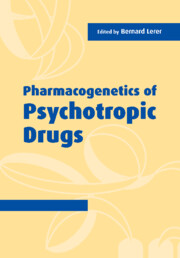Book contents
- Frontmatter
- Contents
- List of contributors
- Part I Introduction
- Part II Clinical background and research design
- Part III Molecular background
- Part IV Pharmacokinetics
- Part V Specific psychotropic drugs and disorders
- 10 Clozapine response and genetic variation in neurotransmitter receptor targets
- 11 Genetic factors underlying drug-induced tardive dyskinesia
- 12 Functional gene-linked polymorphic regions in pharmacogenetics
- 13 Alternative phenotypes and the pharmacogenetics of mood and anxiety disorders
- 14 Pharmacogenetics of anxiolytic drugs and the GABA–benzodiazepine receptor complex
- 15 Genetic factors and long-term prophylaxis in bipolar disorder
- 16 Genetic influences on responsiveness to anticonvulsant drugs
- 17 Apolipoprotein E as a marker in the treatment of Alzheimer's disease
- 18 Genetic variation and drug dependence risk factors
- Part VI Pharmacogenetics and brain imaging
- Part VII Industry perspectives
- Index
15 - Genetic factors and long-term prophylaxis in bipolar disorder
from Part V - Specific psychotropic drugs and disorders
Published online by Cambridge University Press: 20 August 2009
- Frontmatter
- Contents
- List of contributors
- Part I Introduction
- Part II Clinical background and research design
- Part III Molecular background
- Part IV Pharmacokinetics
- Part V Specific psychotropic drugs and disorders
- 10 Clozapine response and genetic variation in neurotransmitter receptor targets
- 11 Genetic factors underlying drug-induced tardive dyskinesia
- 12 Functional gene-linked polymorphic regions in pharmacogenetics
- 13 Alternative phenotypes and the pharmacogenetics of mood and anxiety disorders
- 14 Pharmacogenetics of anxiolytic drugs and the GABA–benzodiazepine receptor complex
- 15 Genetic factors and long-term prophylaxis in bipolar disorder
- 16 Genetic influences on responsiveness to anticonvulsant drugs
- 17 Apolipoprotein E as a marker in the treatment of Alzheimer's disease
- 18 Genetic variation and drug dependence risk factors
- Part VI Pharmacogenetics and brain imaging
- Part VII Industry perspectives
- Index
Summary
OVERVIEW
Response to long-term lithium treatment in bipolar disorder appears to be related to the family history of a patient. Conversely, some studies have indicated that treatment response could identify a subtype of bipolar disorder characterized by a stronger role of genetic factors and possibly by major-gene effects. Several research groups have now collected samples from patients treated with lithium and these are being studied by molecular genetic methods. These studies aim to identify genes associated with the treatment response or to map genes for bipolar disorder in homogeneous populations of treatment responders. Preliminary findings with a number of candidate genes have produced mostly negative findings, but several promising associations have been also identified, for instance, an association of lithium-responsive bipolar disorder with the gene for phospholipase Cγ1. Further research will be needed to examine differences between genetic factors involved in treatment response as opposed to genes associated with the illness. One possible research strategy appears to be a study of pairs of relatives concordant for the illness but discordant for their treatment response. Other important areas of research are phenotype definition, especially definition of long-term prophylactic response, and studies of biochemical phenotypes and alterations in gene expression.
Introduction
Lithium is the standard treatment for bipolar disorder. In recent years, several other treatments have appeared promising, mainly anticonvulsants, but also calcium channel blockers and other drugs.
Response to lithium appears to identify a more homogeneous subtype of bipolar disorder with higher heritability.
Keywords
- Type
- Chapter
- Information
- Pharmacogenetics of Psychotropic Drugs , pp. 320 - 332Publisher: Cambridge University PressPrint publication year: 2002
- 1
- Cited by



